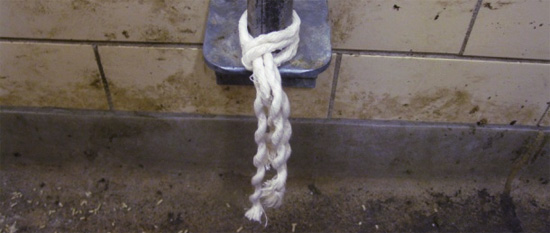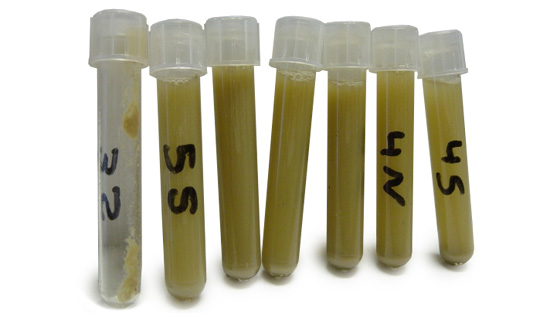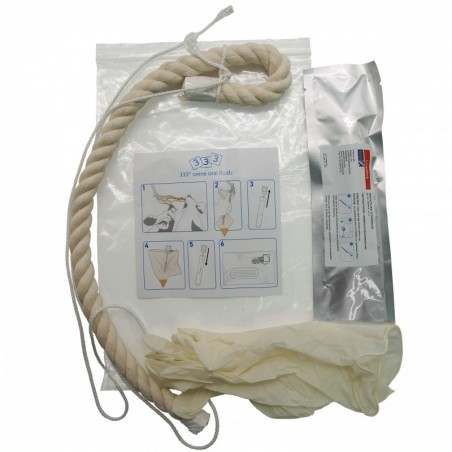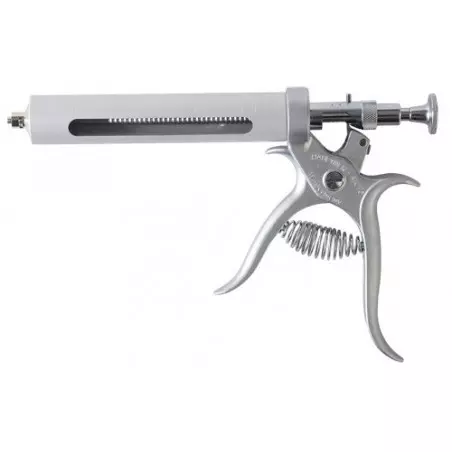Over the last several years, new sampling, monitoring and diagnostic tools for the swine industry that are faster, simpler and more cost effective have been developed and validated.
One of these techniques is the sampling and use of oral fluids (saliva) as specimens for diagnostics in swine. This technique has been validated experimentally for PRRSV, PCV2 and Influenza, and is being routinely used in production systems in the US for the detection of PRRSV and Influenza in the population. Briefly, the technique is based on suspending a cotton rope in a pen so that the pigs will chew at it, leaving behind their saliva (Prickett et al. 2008).
1. Sampling:

Materials needed: 100% cotton rope (not chemically treated), scissors, plastic bags (Ziploc®) and sterile plastic tubes with a conical or rounded base and with enough capacity for the volume of the sample (5cc, 10cc, or 20cc).

Key points:
- The number of ropes necessary in order for the simple to be representative depends on the population size, distribution of the facilities, and pen size. (In facilities with one floor with 1000 animals, 6 ropes are considered enough to detect 10% prevalence with 95% reliability (Detmer et al., 2010)).
- The diameter of the rope and the height it should be hung at will depend on the age of the animals, but it should be easy to access for the whole group.
- 30 min. is sufficient time for 75% of the animals, in a pen of 25-30 animals, to come into contact with the rope, a percentage that increases to 90% if we hang two ropes at the same time.
- Before collecting the rope, make sure it is saturated with saliva (this will help determine whether it has been hung for enough time).
2. Collecting the samples:
The wet part of the rope is cut off and deposited in a clean plastic bag. The saliva is extracted as shown in the images and the samples are decanted in sterile tubes.
Precautions: The extraction of the saliva should be done as quickly as possible after collecting the ropes. Be sure to handle the rope directly as little as possible in order to avoid cross contamination. Refrigerate the samples quickly.


3. Conservation:
- The dirt on the samples (artifacts) can interfere with the diagnostic results. Therefore the saliva must be centrifuged (1000-2000 rpm/30 min.) or at least let the dirt particles present in the simple settle at the bottom of the tube over a period of 60 minutes. With the supernatant, proceed to analysis or conservation.
- The samples should be kept refrigerated (4-10°C). At 4°C they can be kept for 12 days before any alteration in the detection of PRRSV through PCR occurs. In order to conserve the samples they should be frozen (-20°C o -80°C).
4. Analysis:
The detection of viral and bacterial pathogens is carried out through Polymerase Chain Reaction (PCR). The viral RNA of PRRS and Influenza can be detected after 24 h. The detection of PRRSV and PCV2 antibodies can be carried out through the use of an ELISA test. This supposes another alternative to PCR in order to lower diagnostic costs. However, the viral isolation of PRRSV and PCV2 isn’t yet being carried out, and in the case of Influenza, the isolation percentage based on positive PCR oral fluids is 51%.
5. Advantages and limitations of the technique:
The monitoring of a population through oral fluids can be a lower cost diagnostic tool as long as the number of pigs sampled keeps increasing, and in the future, the pathogens that can be detected as well.
Sampling doesn’t require specialized personnel and also, the curious nature of the pigs facilitates the sampling by interacting and playing with the rope while they leave their saliva on it.
With the oral fluid samples we achieve a greater representation of the population and the ability to highlight low prevalence infections (≤10%) is equal or superior to the traditional 30 individual samples.
Oral fluid samples are representative of the population, but they can never substitute individual samples for the isolation of a microorganism.
It’s very important, in order to avoid false negatives, to avoid pooling the samples and that the verification of the samples be processed in a laboratory familiar with the technique of saliva diagnostics.
For more information:
http://vetmed.iastate.edu/vdpam/disease-topics/oral-fluids
http://www.vdl.umn.edu/guidelines/oralfluids/home.html







